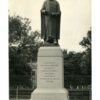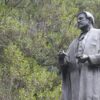Samuel James Way (1836–1916) occupied important and influential positions in South Australia at the turn of the nineteenth century. His ambition, talent and energy combined with good fortune, led to a stellar career in the law and public life.
The Man
Samuel Way was born in Portsmouth, Hampshire, England on 11 April 1836 and arrived in Adelaide in 1853. He undertook a legal apprenticeship and was admitted to the Bar in 1861. He was made a Queen’s Council in 1871 and by 1872, due to the death of the senior partner, had a strong legal practice.
In 1875 Way was elected to the House of Assembly as member for Sturt and within months became attorney-general in the ministry of James Boucaut. Much to the disapproval of the bench Way moved directly from the position of attorney-general to chief justice on the death of the incumbent. He took his seat on the bench of the Supreme Court in March 1876. In 1896 Way was made a Privy Councillor. A year later he became Australia’s only representative on the Judicial Committee of the Privy Council. Way did not have a law degree, but was awarded honorary degrees from Oxford and Cambridge universities among others.
Way was active in educational, cultural and philanthropic organisations. He became vice-chancellor (1876) and then chancellor (1883–1916) of the University of Adelaide. On ceremonial occasions he wore a wig and gown in lieu of academic dress, to which he was not entitled. Samuel Way supported the establishment of a children’s hospital and was president of the Adelaide Children’s Hospital Board from its foundation in 1876 until 1915. He was president of the Public Library, Museum and Art Gallery Board (1893–1908), a member of the Botanic Garden’s Board and a Grand Master of South Australian Freemasons. In addition to these activities Way found time to pursue his interest in sheep farming. He was responsible for the introduction of an improved Shropshire breed to South Australia.
Sir Samuel Way was made lieutenant-governor of South Australia for life in 1890. In 1899 he accepted a baronetcy.
Way was a staunch Methodist, but this did not prevent him from having a ‘secret’ life and family. He maintained an intercolonial relationship with former chamber maid Susannah Gooding over many years and was father to at least five of her six children. Way supported and visited them in Tasmania and then Melbourne. He was grief-stricken when Susannah died in 1888. On 11 April 1898 he married the 44-year-old widow Katherine Gollan (late Blue, née Gordon).
The memorial
Early in 1914, while Way was still alive, a group of influential friends decided to erect a statue in his honour. An organising and fundraising committee was formed chaired by Sir Langdon Bonython, owner and editor of the Advertiser newspaper. Other members of the committee included architect Walter Bagot, Bank of Adelaide chairman Arthur Waterhouse, businessman James Gartrell and parliamentarian and company director David Gordon (secretary). This group was able to obtain sufficient funds for a statue from just 16 donors within a few days.
English sculptor Alfred Drury, whose work Way favoured, was commissioned to create the statue in 1915. Ill-health prevented Way from travelling to England to sit for Drury and he died in 1916 before the statue’s completion. A model was made within a year of commissioning, but the work of casting the bronze could not be undertaken until after the war because foundries had been commandeered for military purposes. Eventually, in 1923, the Orient Steam Navigation Co. brought the statue to Adelaide free of cost.
The statue was unveiled by Chief Justice Sir George Murray on 17 November 1924 before a large gathering of the judiciary and representatives from other organisations with which Way had been associated. Sir Langdon Bonython was absent, being unable to return from England in time. Lord Mayor Charles Glover accepted the statue on behalf of the City of Adelaide.
The bronze statue, standing on a granite pedestal, was placed in front of the University of Adelaide. Way is dressed in judicial robes and is caught in the process of giving an oration. The pedestal was designed by Walter Bagot and erected by J Tillett.






Comments